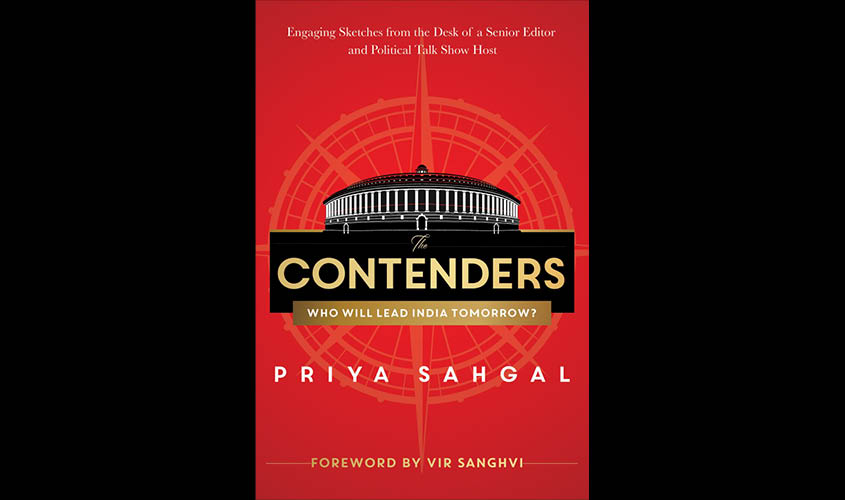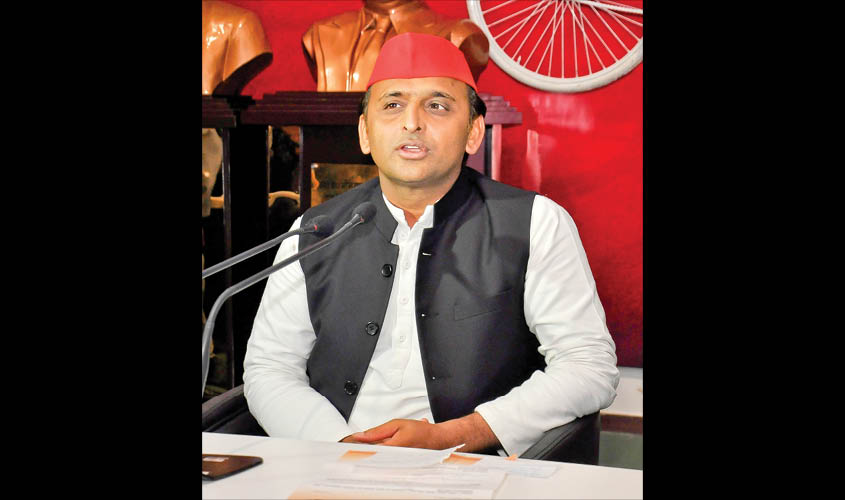In her about to be released book The Contenders, political talk show host Priya Sahgal has profiled 16 emerging political leaders under the age of 55. Reproduced below are excerpts from the chapter on Akhilesh Yadav.
Akhilesh Yadav was three years old when he was taken by the family accountant (Tewariji) to be enrolled at the local nursery school at Safai in rural Uttar Pradesh. There the boy who was brought up as Tipu by his grandmother and aunt (with an ailing mother and a largely absentee father hovering in the background) was asked his name. A bit flustered, Tipu admitted that he had no formal name. S.N. Tewari, the accountant, gave him a choice of three names. ‘I liked Akhilesh the best,’ he recalls with a smile. And Akhilesh it has been ever since. Of course, when he became Uttar Pradesh’s youngest chief minister (CM) at age 38 in 2012, his supporters reverted to his nickname shouting with glee—‘Tipu Ban Gaya Sultan!’
So while he is a dynast he has had to pretty much figure out his legacy right from the start. Even when he was the CM, he was not allowed a free hand with his father and a coterie of uncles calling the shots. It was Mulayam Singh Yadav (his father), Shivpal Yadav (father’s brother), Ram Gopal Yadav (their cousin) and Azam Khan (a powerful Muslim leader) who ruled by proxy. Akhilesh was left with the ceremonies of office but not the power. The dominant joke in Uttar Pradesh then was that the state was being ruled by ‘four-and-a-half ’ CMs.
Towards the middle of his tenure, somewhere in 2014 a national magazine referred to his rule as ‘Andher Nagri Chaupat Raja’ (confused ruler, chaotic state). Always more sensitive to national headlines than local ones this was a ‘Mirror Mirror on the Wall’ moment for Akhilesh. He had ridden to power on his Kranti Rath (Wheels of Revolution), promising change, presumably for the better, but the wheels of change had got stuck in the politics of the same.
Akhilesh realised that in order to give himself a fighting chance in the state polls due in 2017 he had to change the narrative. And do it fast. So he did two things. One: he put development projects on a fast track. A 326 km long state-ofthe-art expressway connecting Lucknow to Agra was flagged off and completed in a record time of 23 months; work began on a metro in the capital city of Lucknow and a river front with landscaped parks and cycle ways was sanctioned on the banks of the Gomti. Apart from these, a last minute push saw the chief minister go into overdrive and flag projects worth Rs 60,000 crore during his last month in office. An appropriate new slogan—‘Kaam Bolta Hai’ was coined to showcase Akhilesh as the new age, development-oriented neta. No matter that it was a slogan set more on foundation stones than completed works, it showed the right intention.

Who Will lead India tomorrow?
Author: Priya Sahgal
Publisher: Simon & Schuster
However, Akhilesh Yadav had a bigger problem at hand. He realised that whatever initiatives he had taken in terms of development were over-shadowed by the image of a CM held hostage by his father and uncles.
Accordingly, six months before the polls Akhilesh began to distance himself from the ‘old guard’ culminating in a dramatic face off in December 2016. Even though he rebelled against his father, he did so in a respectful and reluctant tone, thereby giving the impression of one who had no choice. ‘My revolt against my father was not planned or deliberate. It was forced by circumstances. If I win I will attribute my win to my father,’ he told me in the middle of the 2017 state election campaign (NewsX Cover Story: Campaign Trail with Mr & Mrs Akhilesh Yadav). This won him kudos in the court of public opinion.
Another factor that prompted him to rebel against his father was the influence his ‘Amar Singh Uncle’ had over Mulayam. The portly figure of Amar Singh looms large over the Yadav family saga. A powerful Lutyens’ Delhi networker, Amar Singh became friendly with Mulayam in 1996 when the latter was a defence minister in the Deve Gowda government. Soon the dhoti-clad Netaji became a regular add-on at Amar Singh’s flamboyant bashes in Delhi’s five-star hotels, exchanging his socialist credentials for a socialite tag. This did not go down well with Akhilesh, Ram Gopal Yadav and Azam Khan. The family bided its time and when the Samajwadi Party (SP) was defeated in the 2007 Assembly polls, the trio began voicing their apprehensions against Amar Singh with Azam Khan leading the charge. Eventually, in 2009 Mulayam and Amar Singh parted ways. However, less than a decade later, Amar Singh was back in Mulayam’s life and Akhilesh was fearful of losing his grip over the party (and his father) once again. As he told his friends who chided him for taking on his own flesh and blood: ‘What could I do? I had no choice.
By making this a fight against the outsider Amar Singh, instead of his father, Akhilesh managed to convert the headlines from a legacy grab to legacy preservation. His little revolt may have come too late for his party’s fortunes in the 2017 Assembly as the SP was reduced to an all-time low of 47 seats. But at 43
years, it was not too late for Akhilesh himself. Even in defeat, Akhilesh showed a remarkable capacity for reinvention backed by a strong survival instinct. Less than a year after his Assembly drubbing he reached out to his father’s arch rival—the Bahujan Samaj Party (BSP) leader Mayawati and struck an alliance with her against the Bharatiya Janata Party (BJP) for the Lok Sabha by-polls in Gorakhpur and Phulpur held in March 2018. The duo defeated the BJP and once again Akhilesh was back in the reckoning as one who should not be underestimated. Especially when he repeated this formula and combined with the Rashtriya Lok Dal (RLD) to wrest the high profile Kairana seat from BJP two months later…
***
But, let’s get back to the 2012 campaign. By the time Akhilesh’s Kranti Rath had covered 9000 km and 215 of the state’s 403 constituencies, an alternate narrative was taking shape, much to his father’s surprise and Uncle Shivpal’s obvious dismay. The crowd had begun looking at Bhaiyaji (as they called Akhilesh) as the next Netaji (that is what Mulayam is known as). Congress leader and analyst Surendra Rajput pointed out: ‘Akhilesh was seen as a pocket-book edition of Mulayam Singh.’ And then quipped, ‘Pocket books always sell more.’
Even before the last ballot was cast in Uttar Pradesh, I wrote the cover story for India Today (magazine).

The Hindi edition had Akhilesh’s picture with the caption: ‘Tajposhi ki Tayaari’ (Ready for Coronation). We had declared him CM even before the final vote had been cast. Unfortunately, his party took a little longer to do that even though the SP swept the election with 224 of the state’s 403 MLAs.
There was a reason for the delay. The opposition came from within. Uncle Shivpal threw his own hat in the ring claiming that it was not Akhilesh’s poster boy appeal but his own organizational team that was responsible for the win. Some of Akhilesh’s supporters even put a copy of India Today on Mulayam’s desk at his party office and peeped anxiously from 30 the contenders the windows outside to see if he would get the message.
The affable Ashish (Sonu) Yadav who handles the local media for the SP, remembers how at first Mulayam did not even glance at the magazine when it was placed before him but once they had all left the room picked up the copy and smiled when he saw the cover proclaiming his son as the next CM. Later it seemed that the 72-year-old Mulayam had changed his mind—or had been persuaded to—for he still did not announce Akhilesh as the party’s choice for CM. Instead he told his colleagues that he was keen to become CM for the fourth term simply so he could equal his bête noire Mayawati’s record; she too is a four-term CM.
Hearing this, an angry Ram Gopal Yadav who was batting for Akhilesh snorted and said, ‘CM record banne ke liye nahin bante hain’ (Don’t have to become a CM just to create records). After Janeshwar Mishra’s demise Ram Gopal had donned the mantle of a party ideologue simply because he carried the nomenclature of Professor and was considered the ‘padha-likha’ (literate) face of the party.
At this point it would be imperative to understand the netaji-betaji (father-son) equation. When Akhilesh was very young, and his mother Malti Devi was still alive, Mulayam met his second wife, Sadhna.
The SP patriarch also has another son Prateek with Sadhna. According to an SP insider, ‘The equation between father and son was never intimate. Akhilesh would not meet his father for three to four days and when he did the conversation was minimal.’
Akhilesh was sent off to a boarding—Dholpur Military School in Rajasthan—and graduated in environmental engineering from Mysore University after which he went to Sydney where he furthered his studies on environment impact assessment. In fact, the first time he realized that his father was someone ‘important’ was when his father came to visit him at his school and the UP chief minister’s helicopter touched down on his school grounds.
Finally, it was decided that Akhilesh would be the CM and that the name would be proposed by Azam Khan (a Mulayam loyalist) at a meeting of the party’s National Executive. Knowing his cousin all too well, Ram Gopal did not leave any scope for a last minute coup by Mulayam. Before the proceedings began, he took the mike and announced firmly: ‘Now Azam Khan will propose Akhilesh Yadav’s name as the next chief minister.’
It turned out to be a pyrrhic victory. Akhilesh may have got the CM’s chair but it was Mulayam and his two chachas (Ram Gopal and Shivpal) who ran the government.
After the swearing in, the entire cabinet was taken to Subrata Roy, a powerful Lucknow based industrialist’s residence for dinner. This sent a strong message that despite the new age CM, the old powerbrokers were back in business.

